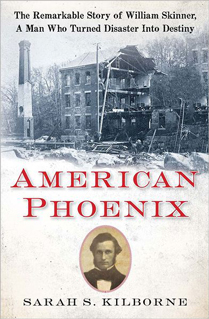Last week I returned to Williamsburg, the town in which the Mill River Flood took place. The Williamsburg Historical Society had asked me if I would speak at their annual meeting this year, in conjunction with the launch of AMERICAN PHOENIX. The meeting was held in the First Congregational Church after a potluck supper and the instant I walked into the room, with everyone’s homemade dishes and warm welcomes, I felt a thrill of coming home.
For much of the past ten years I have been living in Williamsburg in my imagination, recreating its life in the middle of the 19th century. It is the town in which William Skinner began manufacturing silk, where he made a name for himself and, as an immigrant, where he planted his roots in this country. It is the town he once thought he would live in for the rest of his life, and he probably would have, if not for the Mill River Flood and the catastrophic losses that forced him to move. Leaving town would prove to be one of the most difficult – and wisest – decisions of his life, exemplifying the hard truth that sometimes we have to leave what we know to realize what we can. Sometimes we have to change everything in order to survive.
On my way to the church, I passed the stretch of town that was once Skinnerville, the village Skinner had established around his first silk mill. There is no village here anymore, but a few houses remain from the time of the flood, having been salvaged in the aftermath, and they have lined Route 9 now for more than a hundred years. Several were aglow with lights in the twilight and radiated warmth as I drove passed, while autumn leaves fell to the ground around them, carpeting the land in color, in a burst of life before winter. These houses, stalwart witnesses to history, are quietly and wonderfully alive and reflect still another kind resiliency.
I have worked on AMERICAN PHOENIX for so long, and spent so many hours in Williamsburg conducting research that it was unbelievably special for me to be returning, finally, with a finished book to share. As I concluded my reading, there in the First Congregational Church to an audience of more 60 people, I began to feel a certain weight to the moment. There I was, William Skinner’s descendant, more than a century after the disaster, having returned to the place that put his name on the map, reading from my own book about Skinnerville in 1874, to the residents of Williamsburg in 2012, recalling the world that those houses once knew and the flood that took such courage to survive, giving voice to a story that we all, in some way, shared through our collective history. Time seemed to collapse.
Although I am not a native of Williamsburg, I have found a sense of place here in its past, through my family, and I felt such a sense of homecoming that as I was reading my final words I could feel that connection in my bones. Sometimes we don’t know why we do what we do, or where our passions will lead us, but then we find ourselves in a moment where it all comes together, the past, the present, and the future, and everything feels just right. We feel at home.

Hi Sarah,
Great blog! I look forward to more posts!
Best,
Laura